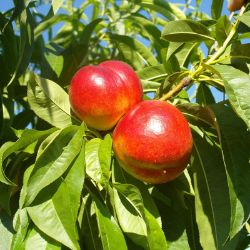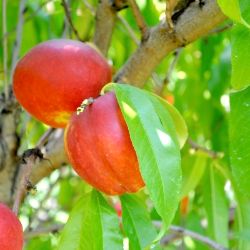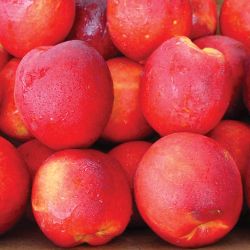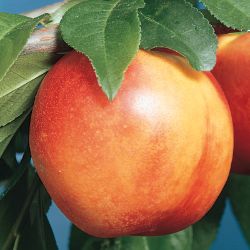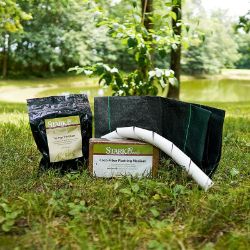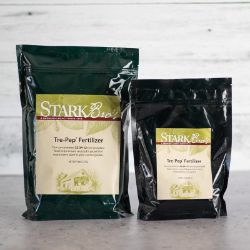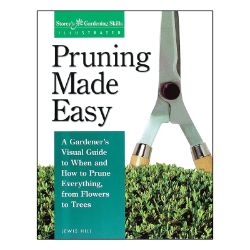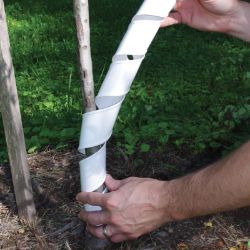Pest & Disease Control for Nectarine Trees
Every fruit tree has the future potential for disease and insect damage. Factors such as location and weather will play a part in which issues your tree encounters. Disease-resistant trees are the best option for easy care; and for all trees, proper maintenance (such as watering, fertilizing, pruning, spraying, weeding, and fall cleanup) can help keep most insects and diseases at bay.
NOTE: This is part 7 in a series of 11 articles. For a complete background on how to grow nectarine trees, we recommend starting from the beginning.
Crown Gall
Trees appear stunted and slow growing; leaves may be reduced in size, little or no fruit. If tree is dead, inspect roots for hard, woody ‘tumors’. Note: many things can cause stunted trees.
Control
- Consult County Extension Agent
Bacterial Canker
Appears on branches and trunk as gummy cankers and water-soaked areas. Fruit develops dark, deeply sunken areas, causing them to be more likely to get ‘Brown Rot’. Cool, wet weather after blooming favors development.
Control
- Consult County Extension Agent
Scale
Usually on bark of young twigs and branches, encrusted with small (1/16”) hard, circular, scaly raised bumps with yellow centers, may also be on fruit. Sap feeding weakens the tree.
Natural Control
- Monterey Fruit Tree Spray Plus
Chemical Control
- GardenTech® Sevin® Concentrate Bug Killer
Tarnished Plant Bug
Yellow-brown winged insect may have black spot or red stripes. Injects toxins into the buds and shoots causing ‘dwarfed’ shoots and sunken areas (cat facing) on fruit.
Natural Control
- Monterey Fruit Tree Spray Plus
Leafroller
Pale yellow or ‘dirty’ green worms. Leaves are rolled and webbed together where insects feed. Eventually becomes skeletonized.
Natural Control
- Hi-Yield® Vegetable & Ornamental Insect Control
- Natural Guard® Caterpillar Killer Spray w/BT
Chemical Control
- GardenTech® Sevin® Concentrate Bug Killer
Aphids
They are the size of a pinhead and vary in color depending on the species. Clusters on stems and under leaves, sucking plant juices. Leaves then curl, thicken, yellow and die. Produce large amounts of a liquid waste called “honeydew”. Aphid sticky residue becomes a growth media for sooty mold.
Natural Control
- Monterey Fruit Tree Spray Plus
Chemical Control
- GardenTech® Sevin® Concentrate Bug Killer
Brown Rot
Fruit turns brownish with lighter spots. Quickly becomes soft, rotten and unusable.
Natural Control
- Monterey Fruit Tree Spray Plus
Chemical Control
- Ferti-lome® Broad Spectrum Landscape & Garden Fungicide
- Hi-Yield® Captan 50W Fungicide
Leaf Curl
Leaves become thickened, puckered and twisted with a reddish-purple color along puckered areas. Turn yellow and drop, may completely defoliate and causes weakening of tree. Any remaining dead leaves should be removed in the fall and all debris removed from the area.
Chemical Control
- Ferti-lome® Broad Spectrum Landscape & Garden Fungicide
Plum Curculio
Adult is brownish-gray 1/5” long, hard-shelled beetle with long snout and 4 humps on back. Cuts a crescent shaped hole under the fruit skins and lays eggs. Worms hatch and tunnel into fruit. Premature dropping of fruit can occur.
Control
- Consult County Extension Agent
Oriental Fruit Moth
Gray moth, 1/2” long. Larvae are white with a brown head, 1/2” long. Larvae burrow into twigs and fruits.
Chemical Control
- GardenTech® Sevin® Concentrate Bug Killer
Bacterial Leaf Spot
Black or brown spots appear on underside of leaves. Often the center falls out leaving a hole with a red halo. Leaves may turn yellow and fall. Fruits also get spots, sunken areas and cracks.
Control
- Consult County Extension Agent
Scab
Spots on young leaves are velvety and olive green turns black; leaves wither, curl and drop. Fruit also has spots, is deformed, knotty, cracked and drops.
Natural Control
- Monterey Fruit Tree Spray Plus
Chemical Control
- Ferti-lome® Broad Spectrum Landscape & Garden Fungicide
- Hi-Yield® Captan 50W Fungicide
Rose Chafer
Beetle has 1/2” long, tan wings with reddish-brown edges. Long, thin hairy legs. Skeletonizes leaves and flowers. Present in large quantities in June and July. Worst on sandy sites near grassy areas.
Chemical Control
- GardenTech® Sevin® Concentrate Bug Killer
Mites
Pinpoint size, many different colors. Found on undersides of leaves. Sap feeding causes bronzing of leaves. Severe infestations have some silken webbing.
Natural Control
- Monterey Fruit Tree Spray Plus
Chemical Control
- GardenTech® Sevin® Concentrate Bug Killer
Borers
Appears as a thick, gummy substance (sap) leaking from round holes on the trunk or in a crotch of the tree. Worms with brown heads and cream-colored bodies tunnel thru trunks that will kill the tree. Once infested, use a fine wire to try to mash or dig them out.
Natural Control
- Bonide® Captain Jack’s™ Deadbug Brew
- Use a fine wire to try and mash or dig them out.
Chemical Control
- Hi-Yield® Vegetable & Ornamental Insect Control
Japanese Beetle
Adult is a metallic green beetle, which skeletonizes leaves. Larvae are a grub, which feeds on turf roots. Check turf product labels for timing of control of grubs. This is more of a problem east of the Mississippi river.
Natural Control
- Hi-Yield® Vegetable & Ornamental Insect Control
- Traps
Chemical Control
- GardenTech® Sevin® Concentrate Bug Killer
Powdery Mildew
Whitish-gray powdery mold or felt like patches on buds, young leaves and twigs. Leaves may crinkle and curl upward. New shoots are stunted. Over winters in fallen leaves.
Natural Control
- Monterey Fruit Tree Spray Plus
Shothole
Small reddish-purple spots appear on young leaves then enlarge and eventually dropping out of the leaf blade leaving a “shot hole.” It appears on fruit, usually in clustered as light brown spots or lesions with dark purple margins.
Chemical Control
- Ferti-lome® Broad Spectrum Landscape & Garden Fungicide
- Hi-Yield® Captan 50W Fungicide
Tent Caterpillar
Hairy caterpillars that enclose large areas in webbing and feed on enclosed leaves. Remove web with rake and burn. Caterpillars are pulled out with webs.
Natural Control
- Monterey Fruit Tree Spray Plus
- Natural Guard® Caterpillar Killer Spray w/BT
Chemical Control
- GardenTech® Sevin® Concentrate Bug Killer
Red-humped Caterpillar
Fully-grown caterpillars can be up to 1½ inch long. They have a brick red hump on its back, red head and red stripes along its body. They feed on leaves. Caterpillars form cocoons in plant liter on the ground, emerging moths are grayish-brown with a wingspan of 1 to 1½ inches. Lay eggs in groups on underside of leaves.
Natural Control
- Natural Guard® Caterpillar Killer Spray w/BT













